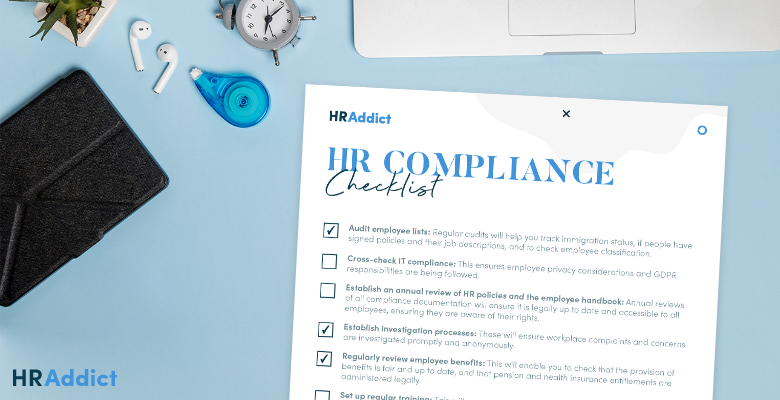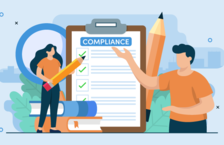When it comes to organizational compliance, human resources are often regarded as one of the most important gatekeepers to ensuring organizations are operating legally, consistently and fairly.
HR’s role in ensuring compliance is broad; they’re responsible for many areas, from privacy protection to health and safety, and HR matters to union regulations. If managed incorrectly, these areas can present significant criminal and financial risks for organizations.
If you’re reviewing your HR compliance processes and wondering where to start, then this employers guide will help demystify all the red tape that HR teams manage, why it’s important, and the most important areas of compliance to consider.
What is HR compliance?
HR compliance is the process of ensuring that organizations are adhering to employment laws, regulations and standards that drive workplace standards.
The vast majority of the processes are focused on looking after the welfare of employees or workers in an organization, though another core purpose of ensuring HR compliance is to mitigate financial loss to the organization, safeguarding its reputation as a trustworthy and fair place to work.
There are many different types of HR compliance, and the regulations shift frequently as governments change and priorities evolve. Keeping on top of these changes is essential.
Types of HR compliance
There are many aspects to HR compliance, but these can be grouped into several main areas, each of which requires the same level of attention and diligence applied to it. Here, we explore these areas and discuss other aspects of HR compliance.
- Contractual compliance refers to obligations defined by employment contracts or contracts between the organization and third parties. These can include terms of service agreements or employment contract terms like pay or working hours.
- Ethical compliance refers to organizations behaving in an ethical, fair and just way, following all laws and honoring business integrity.
- Regulatory compliance refers to the legal obligations an organization has to comply with local and federal governing bodies. These can include immigration compliance or Family and Medical Leave Act compliance.
- Statutory compliance refers to legal obligations as directed by the government. These include top-level laws such as income tax compliance, wage and hour regulations, and General Data Protection Regulation.
- Union compliance refers to how organizations interact with unions, ensuring that the rights of unionized workers are protected, and HR processes are conducted in adherence to union laws.
- Other areas of HR compliance that HR teams need to be up to speed with. These might be more local or company-specific, such as record-keeping standards or how to classify employees.
Key areas of HR compliance
HR looks after a wide remit of compliance areas. Here is a run-through of the main examples of compliance that HR is responsible for managing.
Anti-harassment and discrimination
Employees must be protected from discrimination and misconduct in the workplace. HR teams must, therefore, ensure their workplaces are compliant with legislation like the Civil Rights Act, Americans with Disabilities Act and the Equal Pay Act.
Data protection
HR teams must safeguard employee data and personal information in accordance with laws like the GDPR and the California Consumer Privacy Act. This includes communicating data retention procedures.
Employee benefits
Benefits compliance includes adhering to the Affordable Care Act and the Employee Retirement Income Security Act. Employers must also ensure fair access to benefits, the tracking of them, and continuation of healthcare as stipulated by the Consolidated Omnibus Budget Reconciliation Act.
Employee classification
HR must ensure employees are classified appropriately (exempt or non-exempt) as per the Fair Labor Standards Act. They must also do their due diligence when categorizing employees as contractors to avoid violating labor laws.
Equal employment
Equal employment opportunity prevents discrimination based on age, color, disability, national origin, race, religion, sex and veteran status. HR must review their policies and processes to ensure continuous EEO and Equal Employment Opportunity Commission compliance.
Family and medical leave
HR must ensure their organization complies with the Family and Medical Leave Act, which provides eligible employees with up to 12 weeks of unpaid leave for stipulated family and medical reasons. They must communicate this right and track its usage.
Health and safety
Adherence to Occupational Safety and Health Administration guidelines is essential for a safe working environment. HR must oversee the implementation of safety standards, safety audits and accident reporting, and train employees on health and safety matters.
Hiring and recruitment
Hiring practices must comply with EEO standards. This includes the coordination of fair hiring practices, unbiased interview questions, and verifying employment eligibility through I-9 forms. HR teams must also comply with background check and Fair Credit Reporting Act regulations.
Termination procedures
HR has a duty to avoid wrongful termination claims by ensuring terminations and disciplinary actions follow organizational procedures. They must also process layoffs according to Worker Adjustment and Retraining Notification Act provisions.
Wages and hours
HR must ensure employees are paid accurately and in line with FLSA guidance. This includes minimum wage standards, overtime, and allocation of breaks. They must also ensure accurate timekeeping reporting to prevent wage theft.
How to maintain HR compliance
As you might imagine, navigating these extensive HR compliance obligations is challenging but uncompromisingly important. If you’re wondering where to start, then here’s a 10-point guide on how to maintain HR compliance.
1. Conduct compliance audits
Regular internal audits will help you understand what your organization does well and what it needs to improve when it comes to HR compliance.
Ensure all compliance risk areas are audited (such as payroll, employee lists, immigration information and workplace safety) and that these audits are carried out consistently and their findings are respected and followed up on, even if gaps have been discovered.
2. Create clear policies
HR compliance starts with the creation of comprehensive policies. These provide the bedrock of compliance interventions by providing every employee and manager with a reference point as to what needs to happen.
As you develop policies, ensure all your staff have access to them and are routinely trained on their contents. Ensure they’re updated whenever legislation or processes change.
3. Develop and update employee handbooks
Whereas HR policies are important, they’re also not always accessible or ideal for communicating to line staff. This is where the employee handbook comes in.
Develop a comprehensive and accessible employee handbook that summarizes the key HR policies and informs employees of their obligations, as well as what the company needs to do. Update the employee handbook in line with HR policies, ideally on an annual basis.
4. Encourage open communication
HR teams have a responsibility to nurture a workplace culture where employees are happy to discuss compliance issues, where they’re aware of their rights and feel confident in speaking up if things aren’t being done right.
This will include making managers aware of HR compliance issues and encouraging them to be available to speak with their team. This can be driven through performance reviews or anonymous reporting channels.
5. Implement a whistleblower policy
Whatever open communication channels are used, HR must set up an anonymous whistleblower platform. This is an anonymous, safe and clear process for employees to report serious non-compliance issues without fear of retaliation or retribution.
A whistleblower policy enables HR teams to catch issues early and act on them in an efficient and thorough way. For this reason, the whistleblower policy must clearly be communicated to all employees.
6. Involve other departments
HR compliance is complicated and important, and to maintain it effectively, buy-in and support will be needed from many areas of the business. This might include security or health and safety teams, finance, information technology, talent acquisition, or payroll.
Compliance projects should involve all relevant areas to ensure nothing important is missed and everyone in the organization is pulling in the same direction.
7. Seek external expertise
When creating compliance processes, it’s prudent for HR professionals to consult with external experts such as lawyers, professional services consultants or external auditors.
They might not be cheap, but these individuals can lend their knowledge to ensure your organization remains fully compliant, which can save you a lot of money in the long run. Involving external experts can also help organizations stay on top of compliance issues before they escalate.
8. Set up robust reporting and tracking
HR teams must track all areas of compliance. This can include running regular reports for time and attendance, wage compliance, recruitment activities, accident logs, and many more.
Effective reporting procedures will go a long way in making compliance audits a lot smoother and will also demonstrate to external investigators that you take your compliance responsibilities seriously.
9. Stay updated
HR-related laws and compliance regulations can change often, especially when it comes to national and state laws that don’t always remain in sync. HR teams should monitor updates from government agencies, attend training or seminars, and subscribe to HR newsletters to keep abreast of changing regulations.
Update your policies promptly to reflect such information and set up project teams to ensure the changes are implemented on time, with consideration for those impacted.
10. Train HR teams and managers
Ensure your HR team and managers are regularly trained on compliance matters. Even though a lot of the drive and coordination for HR compliance might start with you, the day-to-day implementation of controls, communication, reports and audits will come from those around you.
Ensure everyone in the business is aware of their responsibilities when it comes to HR compliance, and if they’re not sure, retrain them immediately.
HR compliance checklist

With HR compliance needing a lot of attention and work from many different stakeholders, it can be challenging to stay on top of what’s needed. Here’s a handy 10-point checklist to support you in sustaining HR compliance!
Frequently asked questions
Here are three frequently asked questions that often come up about HR compliance, helping you sense-check what is needed to know about this topic.
What are the consequences of HR non-compliance?
Non-compliance can have several impacts, including loss of reputation, lawsuits (and subsequent fines and penalties), and extensive government audits. It can also damage employee morale and affect other measures like productivity and engagement.
How do we ensure correct documentation for HR compliance?
Maintain accurate records of all HR information, such as tax forms, employment eligibility, payroll records, benefit administration and disciplinary action. Securely store and encrypt it, and ensure data retained only as long as is legally required.
What are the compliance requirements for remote workers?
When it comes to HR compliance, remote workers must be treated the same as employees based in the workplace. That said, HR teams must ensure compliance with wage and hour regulations, and be aware of state-specific laws that might apply where the remote worker is located.
Final thoughts
HR compliance is vital for ensuring organizations are treating their people fairly and controlling exposure to legal and financial risk. This is easier said than done, as HR compliance covers many different areas and can be broken down into focusing on different laws and regulatory guidelines.
HR teams have a duty to manage these areas diligently, ensuring reporting and audits identify risk areas and that organizations respond to ever-changing standards.
Nevertheless, HR compliance is a team goal. Managers must also be aware of HR compliance and be prepared to drive these processes, to support HR in ensuring the whole business is pulling in the same direction to create a great place to work.
Got a question? Let us know in the comments section below.
This article is a complete update of an earlier version originally published in 2017.
